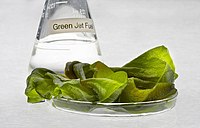
Photo from wikipedia
Current knowledge of yield potential and best agronomic management practices for perennial bioenergy grasses is primarily derived from small‐scale and short‐term studies, yet these studies inform policy at the national… Click to show full abstract
Current knowledge of yield potential and best agronomic management practices for perennial bioenergy grasses is primarily derived from small‐scale and short‐term studies, yet these studies inform policy at the national scale. In an effort to learn more about how bioenergy grasses perform across multiple locations and years, the U.S. Department of Energy (US DOE)/Sun Grant Initiative Regional Feedstock Partnership was initiated in 2008. The objectives of the Feedstock Partnership were to (1) provide a wide range of information for feedstock selection (species choice) and management practice options for a variety of regions and (2) develop national maps of potential feedstock yield for each of the herbaceous species evaluated. The Feedstock Partnership expands our previous understanding of the bioenergy potential of switchgrass, Miscanthus, sorghum, energycane, and prairie mixtures on Conservation Reserve Program land by conducting long‐term, replicated trials of each species at diverse environments in the U.S. Trials were initiated between 2008 and 2010 and completed between 2012 and 2015 depending on species. Field‐scale plots were utilized for switchgrass and Conservation Reserve Program trials to use traditional agricultural machinery. This is important as we know that the smaller scale studies often overestimated yield potential of some of these species. Insufficient vegetative propagules of energycane and Miscanthus prohibited farm‐scale trials of these species. The Feedstock Partnership studies also confirmed that environmental differences across years and across sites had a large impact on biomass production. Nitrogen application had variable effects across feedstocks, but some nitrogen fertilizer generally had a positive effect. National yield potential maps were developed using PRISM‐ELM for each species in the Feedstock Partnership. This manuscript, with the accompanying supplemental data, will be useful in making decisions about feedstock selection as well as agronomic practices across a wide region of the country.
Journal Title: GCB Bioenergy
Year Published: 2018
Link to full text (if available)
Share on Social Media: Sign Up to like & get
recommendations!